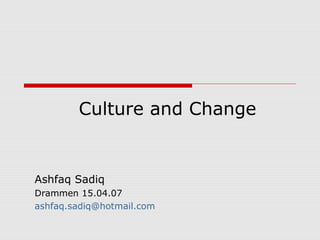
Culture and change
- 1. Culture and Change Ashfaq Sadiq Drammen 15.04.07 ashfaq.sadiq@hotmail.com
- 2. What is Culture? Accumulated habits Learned attitudes Beliefs of people that define for them their general behavior Way of life Total set of learned activities of people Language(s) Geographic location
- 3. Culture: Typology General Human Culture Specific Culture Constituent Culture Cultural Scenes World Culture Scenes
- 4. Culture: Forms Ideal Culture Real Culture Construct Culture
- 5. Culture Forms IDEAL CULTURE: What people believe, think and say they do. REAL CULTURE: What people really think and do. CONSTRUCT CULTURE: Combines what people think and say they do with waht they reall do.
- 6. CHANGE
- 7. Change a Continuous Process Favours New Responses Environmental Pressures Results in Culture Change
- 8. Elements of Change GROUPS (Need) (Motivation) Solution (Innovation) (Borrowing) (Communication) (Change Agent) (Perceived Solution) Cultural Change
- 9. Why Change? Survival Problem Solving
- 10. Where Change Leads to? Alteration Modification Addition Substitution
- 11. Some Characteristics Small or big, it impacts social structure and organization of culture It has implications for political, economic, social and world views
- 12. Explaining Change Unilineal Model All cultures go through basic stages of development: Simple to complex Ecological Model
- 13. Change Mechanisms Evolutionary Interaction
- 14. Evolution Involves: Adaptation Innovation
- 15. Adaptation: End Result Natural and Socio-cultural are the source of all change A result of humans accomodating to their environments An interaction between environment and groups of people
- 16. Innovation Innovation: 1. Discovery or Primary Innovation 2. Invention or Secondary Innovation Diffusion
- 17. Innovation Internal change Borrowing Culture Culture Discovery Changed Environ-ments Invention (Diffuses) Voluntary OR Directed
- 18. Interactional Two levels of interaction: 1. Local: Where change is associated with internal forces 2. External: Where change is associated with external forces
- 19. Interaction People come up with the response to challenge themselves (Innovation) People get it from someone else who already has solved the problem satisfactorily (Acculturation and Diffusion)
- 20. Acculturation A process involving more than one culture Often non-voluntary or directed in character Borrowing/Exporting the solution in its totality Close and continuous contact between or among the cultures More concerned to assimilation, partial or total.
- 21. Diffusion Change brought about through borrowing, with or without cultural contact Selectivity Reinterpretation Reciprocal borrowing (if there is a cultural contact)
- 22. Change Settings Singular and Internal Multi-cultural and External
- 23. Change Processes Voluntary Change Directed Change
- 24. Volunteer Change Non directional Informal interaction between individuals and innovators People choose to change Unplanned Both in singular cultural settings and multicultural settings
- 25. Volunteer Change… Motivation Voulntary Interaction
- 26. Directed Change Planned and Designed Interaction between ‘Change agent’ and group members External process involving contacts with others Meant for collective problems of society Interventionist character
- 27. Directed Change… Change Agent Focal Group Plan characteristics Nature of interaction
- 28. Change Agent Individuals who through their actions and using some form of coercion, attempt to induce people to change some aspect of their lives.
- 29. Change Agents (Internal) People from same group (Communication). Know the cultural codes Could be same person as innovator and disseminator They are from the group but set themselves aside from the group. Role of change agent is assumed
- 30. Change Agent (Internal)… May not know all. May face severe limitations than external ones May be considered as a threat.
- 31. Change Agents (External) Representatives of another culture Roles are assigned They have technical expertise They have a clear purpose to intervene Are part of a big organization/state
- 32. Communication Change process and communication Clear communication Bad communication
- 33. Motivation Varies according to need Varies according to gravity of the problem Age Social norms Religious norms Perceptions
- 34. We can see that:
- 35. Resistance to Change When change agent is not able to communicate appropriately. When people don’t understand/are not well aware about the need/problem Problem/need is not severe enough Relevance of proposed change to problem/need of every day life.
- 36. Resistance to Change… People don’t understand as to how implement proposed change in their lives Indirect communication/interaction Change that focuses upon core systems of culture naturally faces resistance Change that threatens existing power/social structure
- 37. Resistance to Change… When change agents’ performance is poor in focal group as compared to in homeland. When change agent takes position Conflicting perceptions about key role in change process Culture shock leading to withdrawl or rejection
- 38. Resistance to Change… Living habits of change agent Vested interests of leaders (political, social, religious etc.) are at stake Costs involved.
- 39. Thank You
